
Abydos was an ancient city and bishopric in Mysia. It was located at the Nara Burnu promontory on the Asian coast of the Hellespont, opposite the ancient city of Sestos, and near the city of Çanakkale in Turkey. Abydos was founded in c. 670 BC at the most narrow point in the straits, and thus was one of the main crossing points between Europe and Asia, until its replacement by the crossing between Lampsacus and Kallipolis in the 13th century, and the abandonment of Abydos in the early 14th century.

Pergamon or Pergamum, also referred to by its modern Greek form Pergamos (Πέργαμος), was a rich and powerful ancient Greek city in Mysia. It is located 26 kilometres (16 mi) from the modern coastline of the Aegean Sea on a promontory on the north side of the river Caicus and northwest of the modern city of Bergama, Turkey.

Xenophon of Athens was a Greek military leader, philosopher, and historian, born in Athens. At the age of 30, Xenophon was elected commander of one of the biggest Greek mercenary armies of the Achaemenid Empire, the Ten Thousand, that marched on and came close to capturing Babylon in 401 BC. As the military historian Theodore Ayrault Dodge wrote, "the centuries since have devised nothing to surpass the genius of this warrior". Xenophon established precedents for many logistical operations, and was among the first to describe strategic flanking maneuvers and feints in combat.
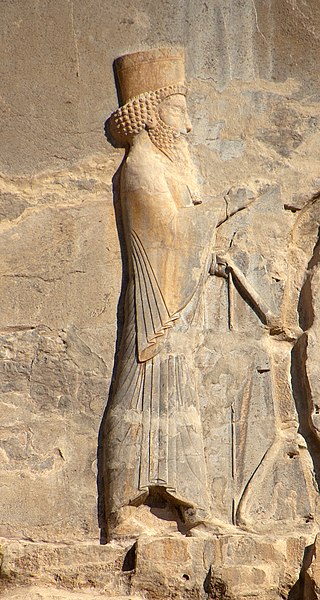
Arses, known by his regnal name Artaxerxes II, was King of Kings of the Achaemenid Empire from 405/4 BC to 358 BC. He was the son and successor of Darius II and his mother was Parysatis.
Artabazos was a Persian general in the army of Xerxes I, and later satrap of Hellespontine Phrygia under the Achaemenid dynasty, founder of the Pharnacid dynasty of satraps. He was the son of Pharnaces, who was the younger brother of Hystaspes, father of Darius I. Artabazos was therefore a first cousin of the great Achaemenid ruler Darius I.
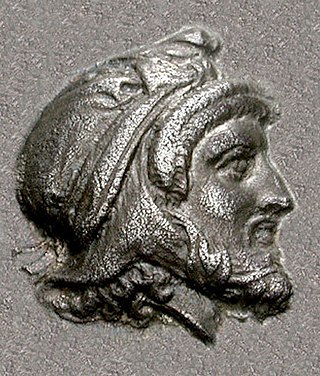
Pharnabazus II was a Persian soldier and statesman, and Satrap of Hellespontine Phrygia. He was the son of Pharnaces II of Phrygia and grandson of Pharnabazus I, and great-grandson of Artabazus I. He and his male ancestors, forming the Pharnacid dynasty, had governed the satrapy of Hellespontine Phrygia from its headquarters at Dascylium since 478 BC. He married Apama, daughter of Artaxerxes II of Persia, and their son Artabazus also became a satrap of Phrygia. According to some accounts, his granddaughter Barsine may have become Alexander the Great's concubine.
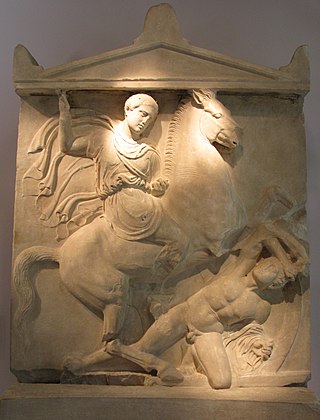
The Corinthian War was a conflict in ancient Greece which pitted Sparta against a coalition of city-states comprising Thebes, Athens, Corinth and Argos, backed by the Achaemenid Empire. The war was caused by dissatisfaction with Spartan imperialism in the aftermath of the Peloponnesian War, both from Athens, the defeated side in that conflict, and from Sparta's former allies, Corinth and Thebes, who had not been properly rewarded. Taking advantage of the fact that the Spartan king Agesilaus II was away campaigning in Asia against the Achaemenid Empire, Thebes, Athens, Corinth and Argos forged an alliance in 395 BC with the goal of ending Spartan hegemony over Greece; the allies' war council was located in Corinth, which gave its name to the war. By the end of the conflict, the allies had failed to end Spartan hegemony over Greece, although Sparta was durably weakened by the war.
Demaratus was a king of Sparta from around 515 BC to 491 BC. The 15th of the Eurypontid line, he was the first son born to his father, King Ariston.
The Orontid dynasty, also known as the Eruandids or Eruandunis, ruled the Satrapy of Armenia until 330 BC and the Kingdom of Armenia from 321 BC to 200 BC. The Orontids ruled first as client kings or satraps of the Achaemenid Empire and after the collapse of the Achaemenid Empire established an independent kingdom. Later, a branch of the Orontids ruled as kings of Sophene and Commagene. They are the first of the three royal dynasties that successively ruled the antiquity-era Kingdom of Armenia.
Mania or Manya, known primarily through Xenophon, was a Dardanian sub-satrap as the tyrant ruler of ancient Dardanus in Asia Minor.

The Achaemenid Empire issued coins from 520 BC–450 BC to 330 BC. The Persian daric was the first gold coin which, along with a similar silver coin, the siglos represented the first bimetallic monetary standard. It seems that before the Persians issued their own coinage, a continuation of Lydian coinage under Persian rule is likely. Achaemenid coinage includes the official imperial issues, as well as coins issued by the Achaemenid provincial governors (satraps), such as those stationed in Asia Minor.

Tiribazus, Tiribazos or Teribazus was an Achaemenid satrap of Western Armenia and later satrap of Lydia in western Anatolia.

Orontes I was a Bactrian nobleman, who served as a military officer of the Achaemenid Empire in the first half of the 4th-century BC. He first appears in 401 BC as the satrap of the satrapy of Armenia. There he participated in the Battle of Cunaxa, where he harassed the Ten Thousand following their retreat. In the same year, he married Rhodogune, a daughter of the King of Kings Artaxerxes II.

Eurysthenes was a descendant of the Spartan king Demaratus.
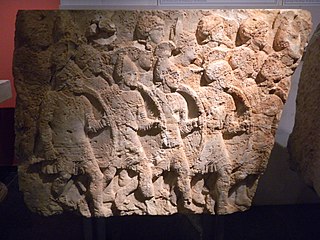
The Great Satraps' Revolt, or the Revolt of the Satraps, was a rebellion in the Achaemenid Empire of several satraps against the authority of the Great King Artaxerxes II Mnemon. The Satraps who revolted were Datames, Ariobarzanes and Orontes of Armenia. Mausolus the Dynast of Caria participated in the Revolt of the Satraps, both on his nominal sovereign Artaxerxes Mnemon's side and (briefly) against him.
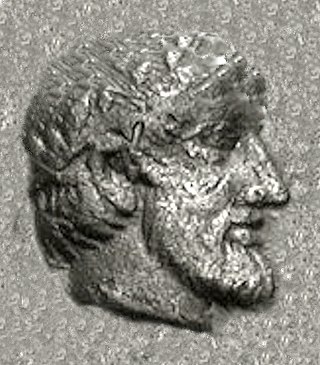
Archeptolis, also Archepolis, was a Governor of Magnesia on the Maeander in Ionia for the Achaemenid Empire circa 459 BCE to possibly around 412 BCE, and a son and successor of the former Athenian general Themistocles.
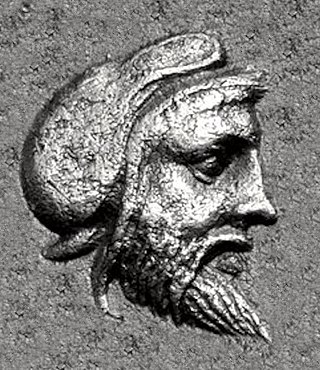
Gongylos, from Eretria in Euboea, was a 5th-century BCE Greek statesman who served as an intermediary between the Spartans and Xerxes I of the Achaemenid Empire, and was a supporter of the latter.
Teuthrania was a town in the western part of ancient Mysia, and the name of its district about the river Caicus, which was believed to be derived from a legendary Mysian king Teuthras. This king is said to have adopted, as his son and successor, Telephus, a son of Heracles; and Eurypylus, the son of Telephus, appears in the Odyssey as the ruler of the Ceteii. The town was situated between Elaea, Pitane, and Atarneus. The nearby towns of Halisarna, Pergamum, and Teuthrania had been given by the Persian king Darius I to the Spartan king Demaratus about the year 486 BCE for his help in the expedition against Greece. Demaratus's descendants continued to rule these cities at the beginning of the 4th century BCE. During the withdrawal of Pergamum from The March of the Ten Thousand, it was attacked by, among others, troops from Halisarna and Teuthrania under command of Procles, son of Demaratus. In the Hellenica, Xenophon relates that Teuthrania, together with Pergamum, Halisarna, Gambrium, Palaegambrium, Myrina and Gryneium were delivered by their rulers to the army that, under the command of the Spartan Thimbron, around the year 399 BCE, had come to the area to try to liberate the Greek colonies from the Persian domain.
Halisarna was a town of ancient Mysia on the north bank of the river Caïcus. The nearby towns of Halisarna, Pergamum, and Teuthrania had been given by the Persian king Darius I to the Spartan king Demaratus about the year 486 BCE for his help in the expedition against Greece. Demaratus's descendants continued to rule these cities at the beginning of the 4th century BCE. During the withdrawal of Pergamum from The March of the Ten Thousand, it was attacked by, among others, troops from Halisarna and Teuthrania under command of Procles, son of Demaratus. In the Hellenica, Xenophon relates that Halisarna, together with Pergamum, Teuthrania, Gambrium, Palaegambrium, Myrina and Gryneium were delivered by their rulers to the army that, under the command of the Spartan Thimbron, around the year 399 BCE, had come to the area to try to liberate the Greek colonies from the Persian domain.

Aba was a Tyrant ruler of the state of Olba in Ancient Anatolia.

















